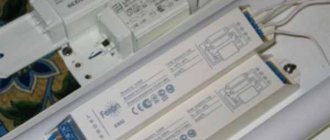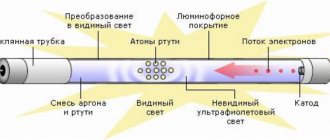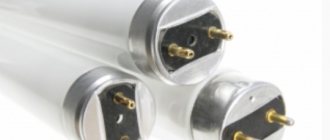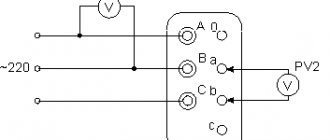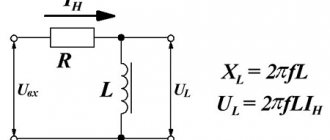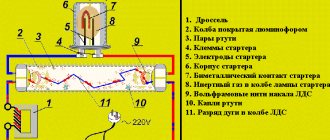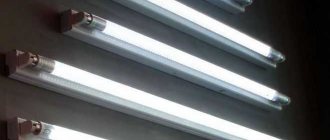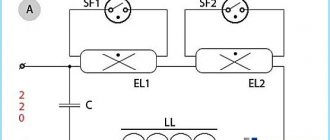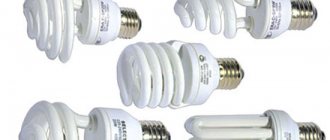What is it needed for?
A fluorescent lamp cannot work like a simple incandescent lamp. To ensure its functioning, an additional device is required that is capable of creating a pulse for electrical breakdown of a gas-filled medium. Such an element is the throttle. It maintains the required power while the lamp is operating.
To use a fluorescent light bulb, it is necessary not only to provide access to current, but also to supply voltage to it. To do this, connect a choke, which limits the increase in the movement of the electric charge when connected to the electrical network.
The main functions of the current limiting device are:
- ensuring continuous operation of the lamp regardless of voltage deviations occurring in the electrical network;
- organizing the supply of optimal and safe current for a particular lamp, facilitating rapid heating when igniting the electrodes;
- stabilization of current discharges at nominal values.
With the help of a choke, a discharge is formed in the luminescent bulb due to the formation of an increased voltage pulse in the winding.
electronic ballasts
Electronic ballast (EPG) is a complex device with many electronic elements. Block diagram of such a device is shown in Fig. 4.
Fig.4. Block – electronic ballast circuit (EPG)
The main difference between electronic ballasts and conventional ballasts is the presence of an inverter, which, using transistor switches, converts a mains voltage of 50 Hz into a voltage with a frequency of 30-40 kHz. Thanks to this, the size and dimensions of this device are reduced. When the circuit is turned on, the LL cathodes heat up, electron “clouds” form near them, and a resonant voltage of about 600 V appears on a capacitor connected in parallel with the lamp, which is sufficient to ignite the lamp.
Fig.5. Electronic ballast device for fluorescent lamps
After the LL is turned on, the voltage across it drops to operating level, and the current is limited by the balanced choke.
Principle of operation
The throttle functions in the lamp together with the starter. The principle of their operation is as follows:
- when voltage occurs in the lamp, electric charges enter the starter, which consists of a cylinder filled with inert gas with contacts and a capacitor;
- due to voltage, the gas is ionized and current flows through the inductor circuit;
- the current increases to 0.5 Amperes due to heating of the bimetal and gas contacts;
- then the cathodes are heated, and the electrodes are released, heating the mercury vapor in the lamp tube;
- ionization is completed when the contacts are instantly closed; ionization is completed when the contacts are instantly closed;
- when the starter temperature drops, they quickly open and the current supply to the cathode and starter is stopped.
The charge formed in mercury vapor provides ultraviolet radiation, under the influence of which illumination is visible to humans.
Specifications
When purchasing a choke, you need to carefully study the technical characteristics of the device. It must correspond to the parameters of a gas-discharge lighting device. The inductance of the inductor plays a significant role. This value indicates the inductive reactance of the device, which helps regulate the electricity supplied to the lamp.
An important value is the coefficient of power loss when maintaining the necessary parameters of the electric power supply of the lamp. The quality of the product also matters.
Basically, the technical data differs depending on the throttle power. According to this value, the device is divided into three groups - “B”, “D” and “C”. Some electronic models have indicators of climatic conditions of use.
Electromagnetic choke for fluorescent lamps
Kinds
There are two types of chokes:
- Electronic. This device works without connecting the starter. Its main advantages are considered to be high switching speed, small dimensions and weight of the product, as well as the ability to ensure a uniform glow of the lamp without flickering. The electronic throttle operates completely silently.
- Electromagnetic. Such a device for fluorescent lamps is connected in parallel with the starter. The electromagnetic throttle has a simple design and is reliable in use. Such products are characterized by low cost. The disadvantages of this device include long-term activation, the presence of characteristic noise during operation, the possibility of flickering during startup, and the need to install a capacitor.
According to the type of networks into which the luminaires are connected, chokes are distinguished:
- household single-phase devices - 220 Volts;
- three-phase devices for fluorescent lamps for industrial use - 380 Volts.
In some models, the choke is located in a special casing, which allows it to be placed in outdoor luminaires. Many devices to provide the glow are placed inside the lamp. This option allows you to reliably protect the throttle from the influence of various external factors.
Electronic choke for fluorescent lamps
Device and circuit
The throttle design contains the following components:
- a core on which a wire of insulating material is wound;
- a special mixture for additional protection of the winding wire, made from fire-resistant substances;
- heat-resistant housing for winding placement.
The standard connection diagram with a starter is the simplest and most common option for connecting fluorescent lamps. Despite some shortcomings, this connection has good performance.
Standard connection diagram for fluorescent lamps
What is a throttle
The inductor is an inductor (to be precise in terms, in this case an inductive coil) located on a ferromagnetic core (usually made of a soft magnetic alloy). This coil, like any conductor, has ohmic resistance, as well as inductive reactance, which manifests itself in alternating current circuits. The design of the choke (ballast) is such that the reactance prevails over the active one. The entire structure is housed in a metal or plastic housing.
Appearance of ballast.
Connection
To connect the throttle according to the starter circuit, you need to follow a few simple steps:
- connect the starter to the contacts that are located on the sides at the output of the lighting device;
- connect a choke to the free terminals;
- Connect the capacitor to the power contacts.
All elements are connected in parallel. Using a capacitor can significantly reduce network noise.
Connecting an electromagnetic choke to a fluorescent lamp
Adviсe
Choosing a new ballast:
- It is necessary to pay special attention to the manufacturer's brand. As a rule, purchasing a cheap product from an unknown manufacturer guarantees low quality workmanship. A reliable ballast must ensure reliable operation for at least 3 years.
- You may accidentally purchase a defective product on the market. Therefore, if your budget allows, it is better to purchase several pieces and negotiate with the seller about the subsequent return of the remaining ones.
- It is better to consult with people who have some experience working with fluorescent lighting devices.
Currently, electronic ballasts, despite the relatively high price, are becoming increasingly popular.
After all, their use allows:
- Increase the service life of fluorescent lamps by using gentle start-up modes and further operation. In addition, the connection diagram does not include a starter that often breaks down.
- Completely get rid of noise and “blinking” during operation.
- Get up to 20% energy savings.
How to check if it's working properly?
The choke is a fairly strong and reliable component of a fluorescent lamp. Therefore, the device fails very rarely.
But still, sometimes a break in its winding or burnout may occur. Also, if the insulating layer between the turns is damaged, the inductor stops functioning. How to determine the serviceability of the throttle?
The test is carried out with a multimeter. A device adjusted to the resistance value is connected to the inductor terminals. If there is a violation in the winding, an infinite resistance is displayed on the measuring device. The minimum indicators of this value indicate the unsuitability of the insulation or a short circuit between the turns.
When the winding burns out in the coil, a characteristic burning smell is felt, which initially emanates from the part during its operation. All described characteristics of a throttle malfunction mainly relate to electromagnetic type devices.
Using a Multimeter
At a certain stage of repair work, you can use a multimeter.
With its help you can determine:
- The integrity of the inductor winding and its electrical resistance.
- Presence of interturn short circuit.
- There is a break in the inductor winding.
However, repairing the winding of an inductor is not an easy task and also requires certain skills. Therefore, if necessary, it is better to entrust such work to specialists.
How to replace?
Sometimes when a throttle fails, they begin to repair it. This requires special knowledge and skills. Most often the part is replaced. Anyone can install a new throttle:
- completely turn off the power supply to the house;
- remove the throttle;
- disconnect the fasteners and wires carrying current to the lamp;
- connect a new throttle to them, inserting it in place of the old one.
Replacement cannot be carried out by simply turning off the lamp, since this will not make the voltage go away.
The choke in a fluorescent lamp is a simple but necessary element to create a glow. Having an understanding of the operation of such a device, you can connect the lamp and replace non-working parts in it without the help of a specialist.
Conclusions.
Although the scheme has a half-century history, it still remains relevant. Ballasts are necessary for the operation of a fluorescent lamp. All components are manufactured and inexpensive. The advantages of this scheme include its simplicity and accessibility of components. Typically, the inductor is the longest-lived component in the circuit.
Of the minuses, it was noted that when using the classic scheme, when the lighting is turned on, flickering is observed for several seconds. This has a bad effect on the useful life of the light source itself. Those. The lamp will work less in such a circuit than when using an electronic starter.
In terms of economic feasibility, if you frequently turn the light on and off, it is not profitable to use such an elemental base; it is easier to purchase an electronic starter, although its purchase will cost more, but it will be a one-time cost.
- Related Posts
- What types of LED strips are there and how to choose them
- Wood's lamp: principle of operation, types, scope of application
- LED warehouse lighting: selection, calculation and installation
